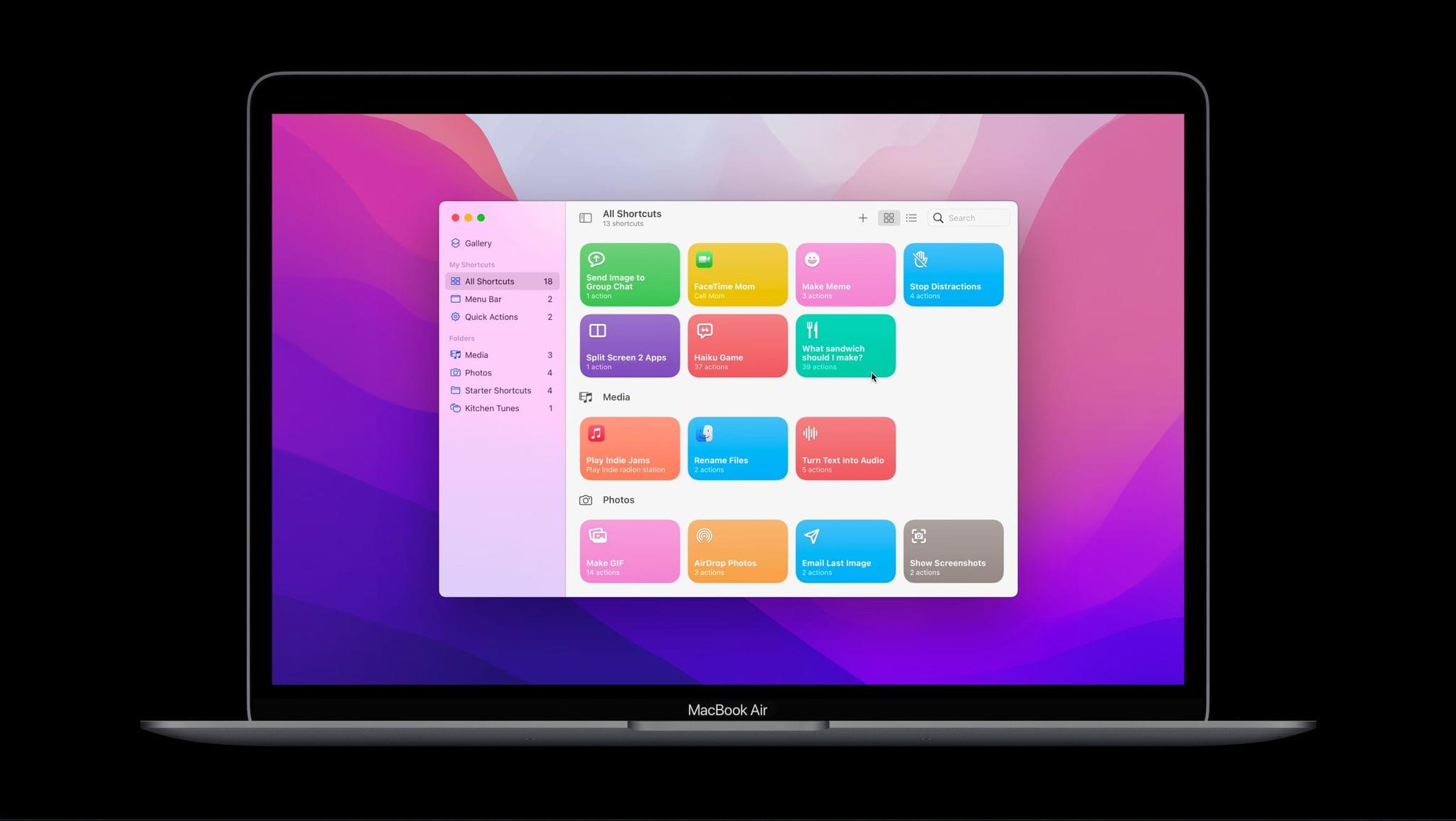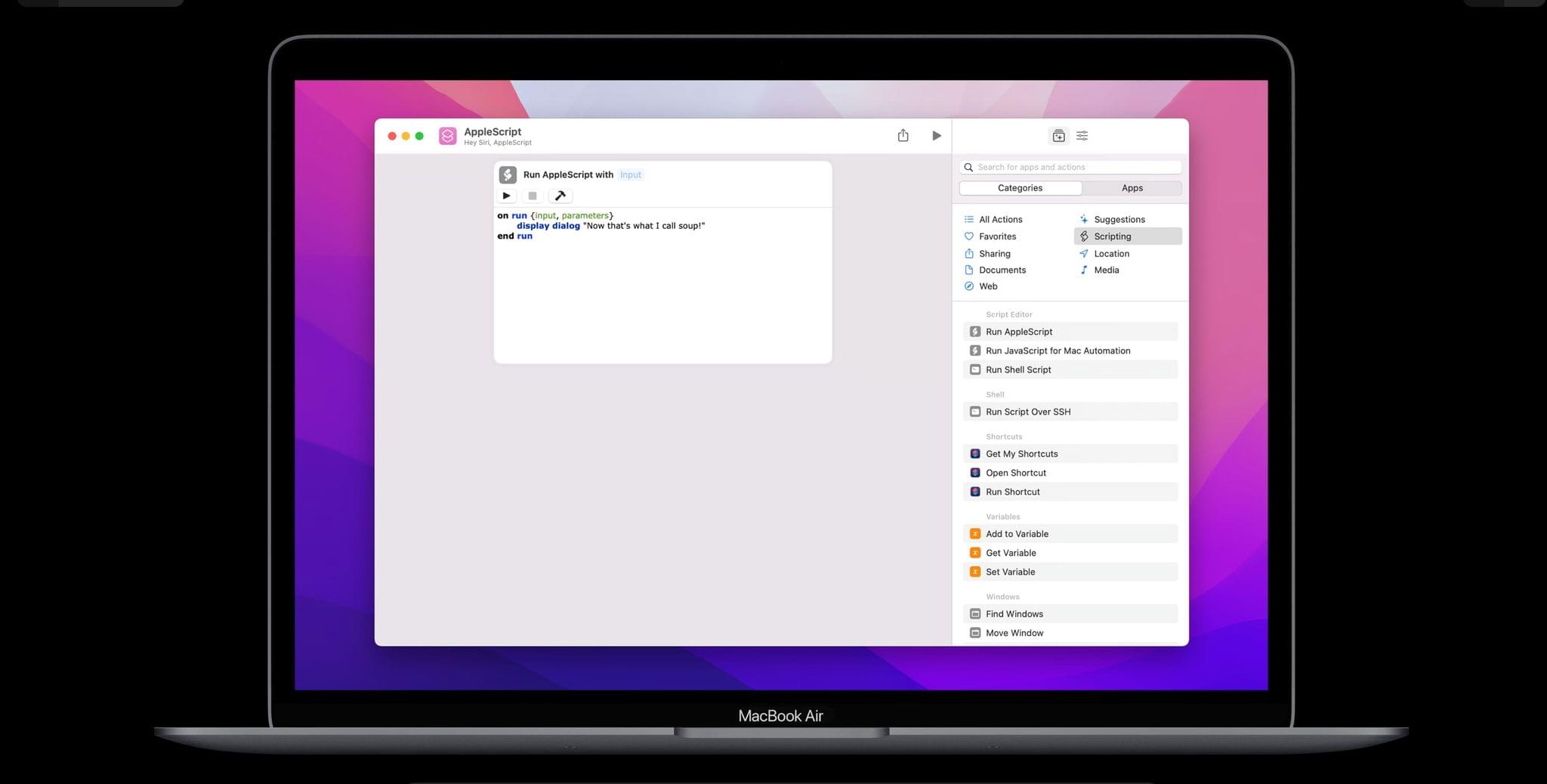To say we’ve followed Shortcuts closely at MacStories is probably an understatement. Federico was relying on it to run MacStories months before it was publicly released as Workflow, and today, the app is deeply embedded in every aspect of our production of the website, podcasts, and Club MacStories content, as well as the way we operate the business.
As someone who works across a Mac and iPad all day, the lack of Shortcuts on the Mac was frustrating, but something I was willing to deal with because the app was such a good fit for the way I worked, even when I had to run it in parallel to my Mac instead of on it. Going into WWDC, though, my feelings about automation on the Mac aligned closely to what Jason Snell wrote on Six Colors earlier this year. As we discussed on AppStories, the time had come for Shortcuts to be available on all of Apple’s platforms, which was why I was so pleased to see it become a reality during this week’s WWDC keynote.
With the addition of Shortcuts to the Mac, Apple has ushered in a new era of automation on the Mac. It’s an important moment for macOS as well as Shortcuts. Automation has a long history on the Mac, but over time, system-level automation stagnated. Updates to things like AppleScript and Automator were sporadic, and their complexity meant their use has been largely relegated to power users.
The situation wasn’t all bad. Excellent third-party options filled the void to offer a wide variety of functionality. Today, you can automate tasks with a long list of apps like Alfred, Hazel, BetterTouchTool, and Keyboard Maestro to name just a few that I use regularly. However, the fragmentation of automation solutions has also resulted in a higher learning curve than many users are willing to scale.
Announcing Shortcuts for Mac into that complex context required Apple to deliver a clear, consistent message about what the Shortcuts on the Mac will mean to everyone from experienced users who rely on existing technologies to newcomers, which I think they accomplished. On the one hand, Apple left no doubt that the company views Shortcuts as the future of automation on all of its platforms, the Mac included. Apple’s words were backed up by its actions, such as the fact that the most popular Automator actions have been replicated as Shortcuts actions. On the other hand, though, Apple has made it equally clear that this will be a multi-year transition and that it isn’t abandoning powerful automation tools like AppleScript, shell scripts, and JavaScript, which will provide flexibility and power beyond the actions that will be shipped this fall when macOS Monterey is released.
There are many interesting details in Shortcuts for Mac, but I’m struck by a couple of big-picture aspects of what Apple seems to be trying to accomplish with the app. The first is the promise of a much-needed structure for automation across all of the company’s platforms. If you watch the WWDC session video on how to make great Shortcuts actions, it’s immediately apparent that the team behind the app has a clear vision of what makes a great action for building shortcuts.

Shortcuts for Mac will be immediately familiar to anyone who has used it on other platforms. Source: Apple.
One of the reasons for Shortcuts’ success on iOS and iPadOS is that reality lines up with the team’s vision. There’s a built-in structure to actions, and the way shortcuts are built is elegant in its simplicity. That helps the app stay out of the way, allowing users to create everything from simple one-action shortcuts to complex ones with hundreds of actions. In both cases, the app itself stays out of the way, for the most part, allowing users to focus on the problem they are trying to solve instead.
That’s not to suggest that there isn’t room for improvement. Of course, there is. Federico and I dedicated an entire episode of AppStories to our Shortcuts wishes. However, the app wouldn’t have made it from an indie app by a few young developers to the engine at the heart of automation across all of Apple’s platforms without getting the fundamentals more than a little right.
The second thing that struck me about Monday’s announcement is how well Shortcuts has been set up to succeed on the Mac. Although I’ve wanted Shortcuts on the Mac for what feels like forever, I think the wait will be worth it in the end. Had Shortcuts been brought to the Mac too early, it would have been starting from a full stop. By waiting until Mac Catalyst apps matured and iPhone and iPad apps could be run on M1 Macs, Shortcuts will enjoy a long list of third-party apps that support it day one. I migrated my M1 MacBook Air to an M1 iMac that I’m testing, and when I installed macOS Monterey, I already had more than a dozen third-party apps to test with Shortcuts. Add to that the fact that AppKit apps can add Shortcuts support, and it’s clear that Apple is sending the message that Shortcuts is the future of automation for all apps, not just a subset built a certain way.
I contacted a few of the developers whose apps should be well-known to MacStories readers to get their perspective on Shortcuts for Mac, asking what impact they think the app will have on automation. Their insights reflect the excitement and opportunity for a new age of automation on the Mac that Shortcuts represents.
Steve Troughton-Smith, the developer of the Internet radio app Broadcasts, the color-picker app Pastel, and other apps, had this to say:
Apple was very deliberate in how it framed Shortcuts on the Mac as the future of Mac automation and the clear replacement for Automator. That’s a huge responsibility for a very young team at Apple, and they’re going to have users on day one that have been using AppleScript and Automator for decades, in arcane, bespoke workflows. There are ancient subsystems throughout macOS that now need to be brought into the modern era and integrated with the Shortcuts world view. Seeing how the Shortcuts folks rise to meet this is going to be fascinating; this is the day Shortcuts became an adult.
Simon Støvring, the maker of Scriptable, Jayson, and Data Jar, had a similar sense that Shortcuts is entering a new chapter of its history:
With the introduction of Shortcuts for Mac, it feels like we’ve entered a new era in automation. In their WWDC sessions, the Shortcuts team talks about a transition from Automator to Shortcuts. Automator has served us well on the Mac for several years, but now there’s a tool that works across macOS, iOS, and iPadOS. This makes automation accessible to new people, and I find that very exciting.
As the creator of apps that take advantage of Shortcuts, Støvring was also glad to see the expansion of the audience and opportunities for developers:
It’s interesting that as Apple is broadening the audience for Shortcuts, they’re also making it easier to share shortcuts by bringing back file sharing.
As a developer of a few Shortcuts utilities, it’s great that I can now release apps built on more or less the same codebase for macOS and reach a larger audience. I’m excited to see what people will do with all the Shortcuts utilities on their Mac!
Greg Pierce, the developer of the automation-focused text editor Drafts, was impressed by the thought and care that has gone into making automation more accessible to a broader audience while continuing to support existing automation solutions:
Shortcuts on the Mac should have an immediate impact. Users with a history of automating workflows on the Mac may not immediately drop everything and flock to Shortcuts, but having a consistent automation story across macOS and iOS is a big win for users.
Shortcuts will make automation more accessible and friendly for users who find the legacy tools (like AppleScript) intimidating or have adopted the Mac platform more recently.
I’m very impressed at how much thought Apple seems to have put into making Shortcuts on the Mac that pushes automation on the platform forward while still embracing the legacy, with support for Automator import, AppleScript and shell scripts, and the like.
Finally, Joe Hribar, the creator of Timery for Toggl, looks forward to Shortcuts for Mac making his app easier to use and understand by users on every platform:
Shortcuts for Mac is going to enable more people to do more things with automation—and make it easier all around: easier to build, easier to understand, and easier to use because it’s available on all their devices. Build it once and use it everywhere.
Specifically for Timery, I’m looking forward to having the same actions as on iOS to quickly perform tasks like starting time entries along with other automations. Time tracking should be quick and easy, and Shortcuts helps make that possible.
When I think back to the first time I saw a YouTube demo of Workflow, which would become Shortcuts after it was acquired by Apple, the app seemed like impossible magic. It didn’t seem possible that an iPad app could do what Workflow did in 2014, but it did.
It’s remarkable that watching that video more than seven years later, it’s still recognizable in the Shortcuts of 2021. The app has matured a lot over the years, but at its core is the same powerful idea the Workflow team struck on in 2014. It’s an idea that adapted concepts pioneered by Automator on the Mac to work on the iPhone and iPad, is now poised to pick up on the Mac where Automator left off.
 at WWDC 2016, less than a year before they joined Apple.](https://cdn.macstories.net/workflow-guys1466419082455-1623332274040.jpeg)
I interviewed the Workflow team at WWDC 2016, less than a year before they joined Apple.
Just over four years ago, Workflow was acquired by Apple and renamed Shortcuts. At the time, there was a lot of uncertainty about what would become of the app that was beloved by legions of iOS geeks, including the MacStories team. In ‘The Future of Workflow,’ Federico laid out best and worst-case scenarios, writing this about the Mac in his best-case scenario:
Under Apple’s guidance, Workflow could grow into a safer, more integrated, extensible automation service and developer platform unlike anything that has ever been attempted on the Mac before.
An optimist at heart, Federico concluded his story with this:
Workflow gives power back to the users. Now only Apple can turn Workflow’s promise into a reality, ushering us into a new era of automation for everyone, on every device, in every app.
I want to believe.
I wanted to believe too. We held our breath, hoped for the best, and watched as the app matured inside Apple, a very different environment than the one where it began. With the announcement that Shortcuts is coming to the Mac, I feel like we can finally let that breath out and relax a little. The questions posed by Federico in The Future of Workflow feel like they’ve been answered. The new era of automation on Apple platforms is now.
You can follow all of our WWDC coverage through our WWDC 2021 hub, or subscribe to the dedicated WWDC 2021 RSS feed.







